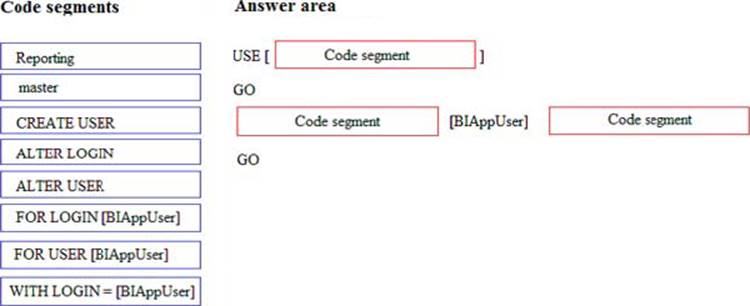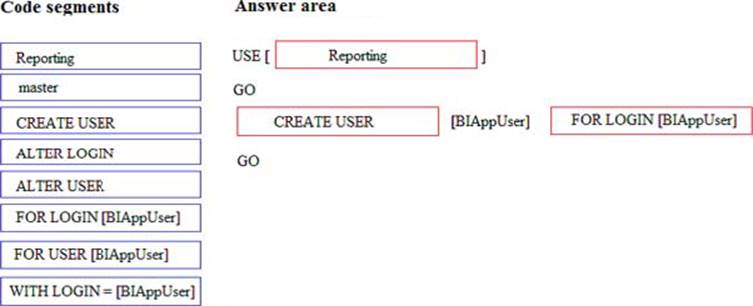How should you complete the Transact-SQL statements?
Topic 6, SQL Server Reporting
Background
You manage a Microsoft SQL Server environment that includes the following databases: DB1, DB2, Reporting.
The environment also includes SQL Reporting Services (SSRS) and SQL Server Analysis Services (SSAS). All SSRS and SSAS servers use named instances. You configure a firewall rule for SSAS.
Databases
Database Name:
DB1
Notes:
This database was migrated from SQL Server 2012 to SQL Server 2016. Thousands of records are inserted into DB1 or updated each second. Inserts are made by many different external applications that your company’s developers do not control. You observe that transaction log write latency is a bottleneck in performance. Because of the transient nature of all the data in this database, the business can tolerate some data loss in the event of a server shutdown.
Database Name:
DB2
Notes:
This database was migrated from SQL Server 2012 to SQL Server 2016. Thousands of records are updated or inserted per second. You observe that the WRITELOG wait type is the highest aggregated wait type. Most writes must have no tolerance for data loss in the event of a server shutdown. The business has identified certain write queries where data loss is tolerable in the event of a server shutdown.
Database Name:
Reporting
Notes:
You create a SQL Server-authenticated login named BIAppUser on the SQL Server instance to support users of the Reporting database. The BIAppUser login is not a member of the sysadmin role.
You plan to configure performance-monitoring alerts for this instance by using SQL Agent Alerts.
DRAG DROP
You create a login named BIAppUser. The login must be able to access the Reporting database.
You need to grant access to the BIAppUser login in the database.
How should you complete the Transact-SQL statements? To answer, drag the appropriate Transact-SQL segments to the correct locations. Each Transact-SQL segment may be used once, more than once, or not at all. You may need to drag the split bar between panes or scroll to view content.

Answer: 
Explanation:
Box 1: Reporting
The user is to be created in the Reporting database.
Box 2: CREATE USER
Box 3: FOR LOGIN [BIAppUser]
Users are created per database and are associated with logins. You must be connected to the database in where you want to create the user. Here is some sample Transact-SQL that creates a user:
CREATE USER readonlyuser FROM LOGIN readonlylogin;
References: https://azure.microsoft.com/en-us/blog/adding-users-to-your-sql-azure-database/
Latest 70-765 Dumps Valid Version with 243 Q&As
Latest And Valid Q&A | Instant Download | Once Fail, Full Refund

